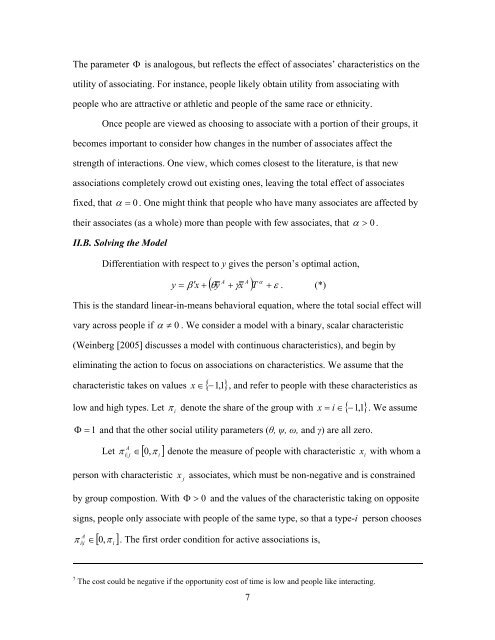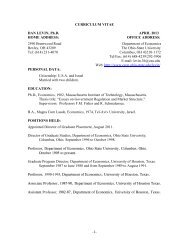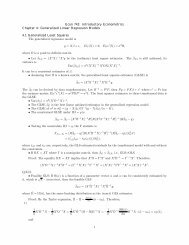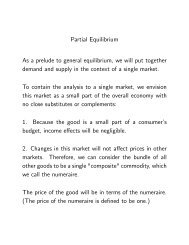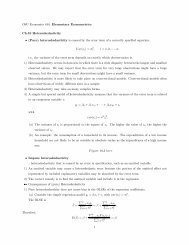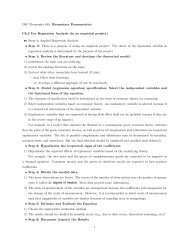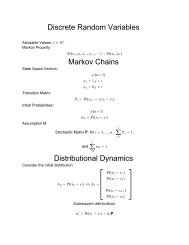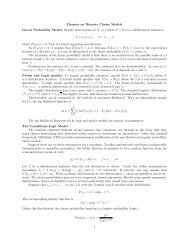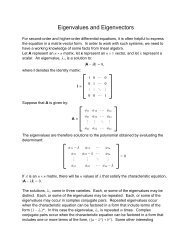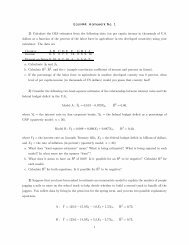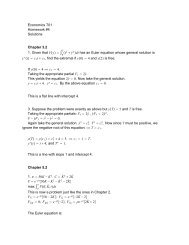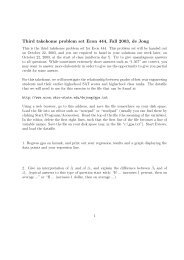Social Interactions and Endogenous Association - Department of ...
Social Interactions and Endogenous Association - Department of ...
Social Interactions and Endogenous Association - Department of ...
You also want an ePaper? Increase the reach of your titles
YUMPU automatically turns print PDFs into web optimized ePapers that Google loves.
The parameter Φ is analogous, but reflects the effect <strong>of</strong> associates’ characteristics on the<br />
utility <strong>of</strong> associating. For instance, people likely obtain utility from associating with<br />
people who are attractive or athletic <strong>and</strong> people <strong>of</strong> the same race or ethnicity.<br />
Once people are viewed as choosing to associate with a portion <strong>of</strong> their groups, it<br />
becomes important to consider how changes in the number <strong>of</strong> associates affect the<br />
strength <strong>of</strong> interactions. One view, which comes closest to the literature, is that new<br />
associations completely crowd out existing ones, leaving the total effect <strong>of</strong> associates<br />
fixed, that α = 0 . One might think that people who have many associates are affected by<br />
their associates (as a whole) more than people with few associates, that α > 0 .<br />
II.B. Solving the Model<br />
Differentiation with respect to y gives the person’s optimal action,<br />
A A<br />
( θy<br />
+ γx<br />
) α + ε<br />
y = β ′ x + T<br />
. (*)<br />
This is the st<strong>and</strong>ard linear-in-means behavioral equation, where the total social effect will<br />
vary across people if α ≠ 0 . We consider a model with a binary, scalar characteristic<br />
(Weinberg [2005] discusses a model with continuous characteristics), <strong>and</strong> begin by<br />
eliminating the action to focus on associations on characteristics. We assume that the<br />
characteristic takes on values x ∈{ −1,1 }<br />
low <strong>and</strong> high types. Let<br />
i<br />
, <strong>and</strong> refer to people with these characteristics as<br />
π denote the share <strong>of</strong> the group with x = i ∈{ −1,1 }<br />
Φ = 1 <strong>and</strong> that the other social utility parameters (θ, ψ, ω, <strong>and</strong> γ) are all zero.<br />
A<br />
Let π [ 0,<br />
π ]<br />
person with characteristic<br />
i| j<br />
∈<br />
i<br />
denote the measure <strong>of</strong> people with characteristic<br />
i<br />
. We assume<br />
x with whom a<br />
x<br />
j<br />
associates, which must be non-negative <strong>and</strong> is constrained<br />
by group compostion. With Φ > 0 <strong>and</strong> the values <strong>of</strong> the characteristic taking on opposite<br />
signs, people only associate with people <strong>of</strong> the same type, so that a type-i person chooses<br />
A<br />
i i<br />
[ 0 π ]<br />
π<br />
|<br />
∈ , . The first order condition for active associations is,<br />
i<br />
7 The cost could be negative if the opportunity cost <strong>of</strong> time is low <strong>and</strong> people like interacting.<br />
7


